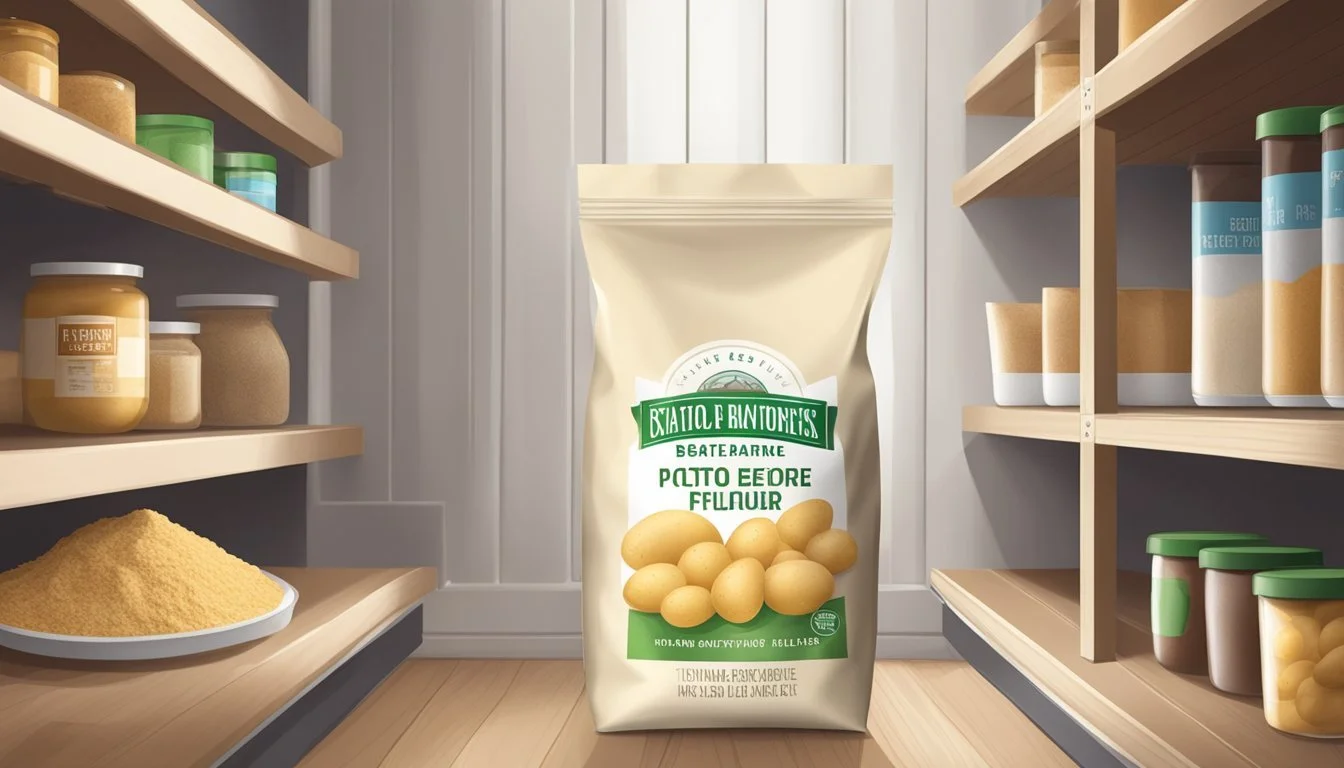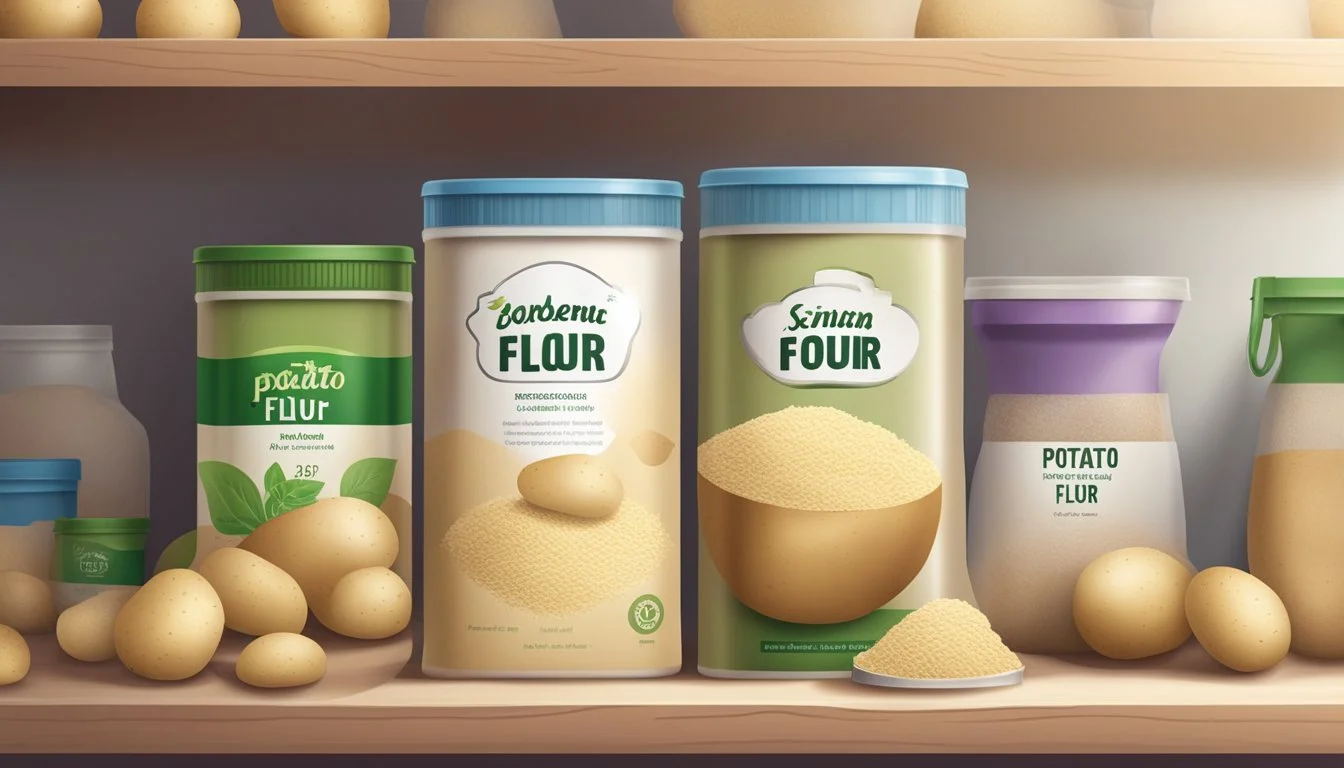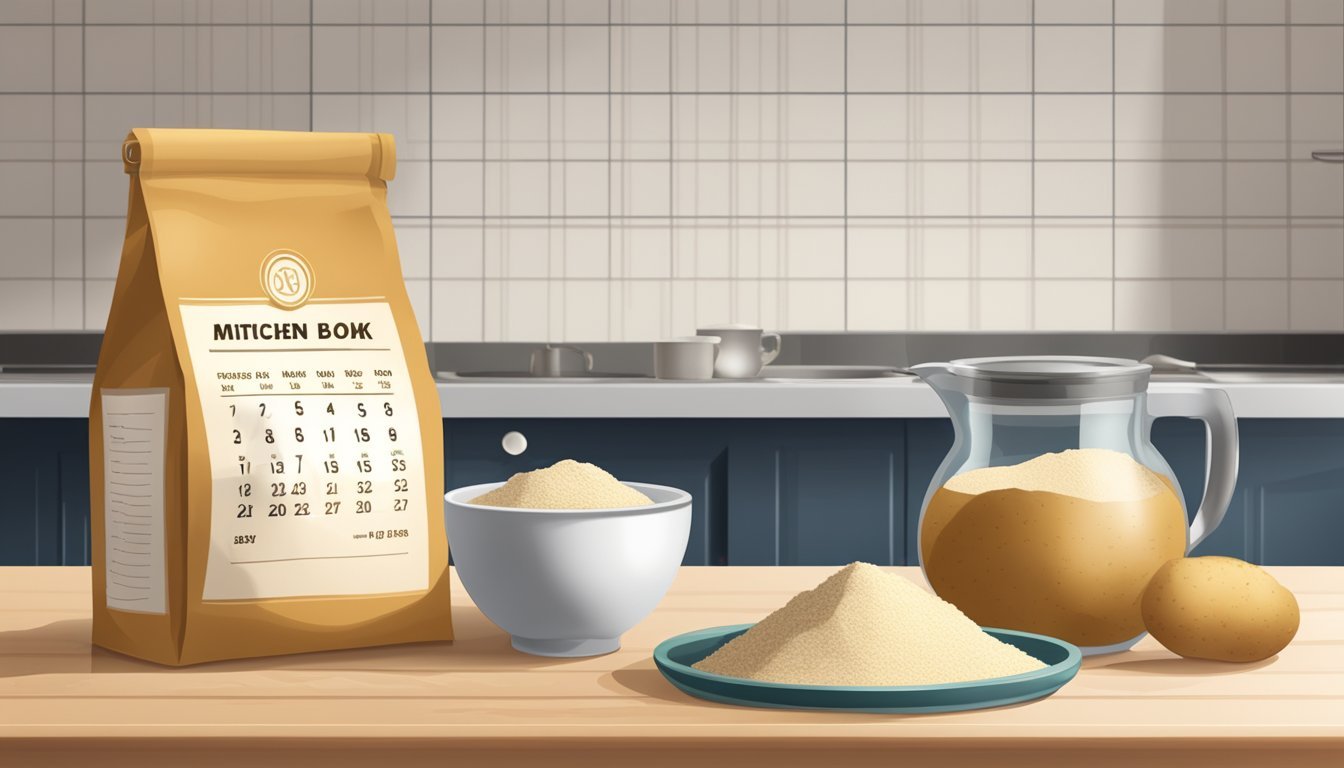How Long Does Potato Flour Last?
Shelf Life and Storage Tips
Potato flour is a fine powder made from ground and dried potatoes, (What wine goes well with potatoes?) offering a variety of uses in cooking and baking, such as a thickening agent for soups and sauces, or an ingredient in breads and cakes. The shelf life of potato flour depends on storage conditions; it lasts several months or even years when stored properly. It is important to store potato flour in a cool, dry place, away from moisture and varying temperatures that can affect its quality.
Once the packaging is opened, exposure to air, moisture, or undesirable odors can impact the flour's freshness. For optimal shelf life, potato flour should be transferred to an airtight container to limit this exposure. Despite the preservative-free nature of the flour, its longevity is notable, with an unopened shelf life ranging from one to two years. However, once opened, it is advisable to use the flour within 6 to 8 months to ensure the best quality for culinary uses.
Understanding Potato Flour
Potato flour is a fine powder made from ground potatoes and is vital for gluten-free baking. It offers distinctive characteristics and serves as a substantial source of protein and fiber in various recipes.
Definition and Characteristics
Potato flour is produced by cooking, drying, and then grinding potatoes to create a fine powder. It retains the flavor and nutrients of whole potatoes, including vitamins, minerals, and a notable amount of fibers and protein. Unlike wheat flour, potato flour is gluten-free, making it an essential ingredient for those with gluten sensitivities or celiac disease.
Nutrient-rich: High in fiber and protein.
Flavor: Distinct, strong potato taste.
Texture: Varies from fine to coarse.
Types of Flour Compared
There are several types of flour, each with unique properties suitable for different applications.
Type of Flour Gluten Content Best Usage Wheat Flour High General baking Potato Starch Gluten-free Thickeners and light baking Potato Flour Gluten-free Dense and moist baked goods Almond Flour Gluten-free Protein-rich, gluten-free baking
Potato flour differs from potato starch, which is extracted solely from the starch of potatoes and does not contain the protein and fiber found in potato flour.
Gluten-Free Baking Essentials
Potato flour is a staple in gluten-free baking due to its ability to improve texture and moisture retention in baked goods. When used in conjunction with other gluten-free flours, it can create a more comparable texture to wheat flour-based recipes. Its high starch content also helps in creating a tender crumb in baked goods.
Texture Enhancer: Contributes to a moist and dense texture.
Binding Agent: Helps in holding ingredients together.
By understanding the properties and uses of potato flour, bakers can effectively incorporate this versatile ingredient into their gluten-free recipes.
Storage Fundamentals
To ensure the longevity and quality of potato flour, one must adhere to specific storage guidelines. These fundamentals are crucial for maintaining the flour’s usability and preventing spoilage.
Optimal Storage Conditions
The key to preserving potato flour's shelf life is to store it in a cool, dry place. Ideally, the temperature should be consistent and not prone to fluctuations. This environment helps in preventing the development of mold and keeps pests at bay.
Best Way to Store Potato Flour
Potato flour should be kept in an airtight container after opening to protect it from moisture and contaminants. If the flour came in a paper or plastic bag, transferring it to a container with a secure lid is highly recommended. If one prefers to use the original packaging, it should be carefully resealed after each use.
Identifying the Ideal Containers
For optimal storage, containers should be:
Airtight: To keep moisture out.
Opaque: To minimize light exposure, which can degrade quality.
Food grade: Ensure materials are suitable for food storage.
Sturdy: To protect from physical damage and pests.
The use of plastic bags is not advised unless they are sealed thoroughly and placed within a more rigid container. If longer-term storage is required, some may opt to store potato flour in the refrigerator or even the freezer to extend its shelf life. In these cases, ensure the flour is well-sealed against condensation and odors.
Potato Flour Shelf Life
Understanding the shelf life of potato flour is essential for maintaining its quality and freshness. Factors like storage conditions and exposure to elements play a critical role in its longevity.
General Shelf Life Expectancy
Potato flour typically has a shelf life ranging from 1 to 2 years if unopened and stored in optimal conditions. Once the package is opened, the flour should ideally be used within 6 to 8 months to ensure its best quality. The precise expiration date may vary by brand and should be checked on the packaging.
Factors Affecting Freshness
Several external factors can impact the freshness of potato flour:
Heat: Extreme temperatures can accelerate the degradation of potato flour, reducing its shelf life.
Moisture: To preserve its freshness, potato flour must be kept in a dry environment. Moisture can introduce mold and spoilage.
Oxygen & Humidity: An airtight container is paramount to protect the flour from oxygen and humidity, which can lead to staleness or clumping.
Storage Location: A cool and dark place is most conducive to prolonging the shelf life of potato flour.
Signs of Deterioration
Indicators that potato flour has surpassed its prime include:
Odor: A rancid or off smell is a clear sign of spoilt flour.
Appearance: Discoloration or the presence of mold points to contamination.
Texture: If the flour has become hard or clumpy, this may suggest exposure to moisture.
Usage in Cooking and Baking
Potato flour is a versatile ingredient commonly used in recipes for its ability to improve texture and add distinctive flavor. It's especially useful in both cooking and baking applications.
Incorporating into Recipes
Cooking: When chefs incorporate potato flour into recipes, they frequently use it to thicken sauces and soups due to its excellent thickening properties. The flour integrates well without altering the basic profile of the dish.
Soups: Mix a small amount of potato flour directly into the broth to achieve a desired consistency.
Sauces: Whisk potato flour into liquids to thicken them without lumps.
Baking: In baking, potato flour is often blended with other flours to create tender baked goods. It is especially popular in gluten-free recipes.
Baked Goods: A portion of potato flour can be substituted for wheat flour in bread, cakes, or pancake recipes.
Pancakes: Include potato flour for moist, fluffy pancakes with a slight earthy taste.
Texture and Flavor Contributions
Texture: Potato flour contributes a moist, dense texture to baked goods, which can be particularly desirable in items like loaf bread and rolls. It also helps to retain water, which keeps products fresh longer.
Cakes and Breads: They gain a tender crumb and extended shelf life from the addition of potato flour.
Flavor: It imparts a subtle flavor that complements various ingredients without overwhelming them. This mild, earthy flavor is particularly well-suited to baked items.
Baked Goods: They obtain a depth of flavor that enriches the overall taste profile.
Safety and Spoilage Prevention
In ensuring potato flour's longevity and safety, recognizing spoilage signs and taking steps to avoid food poisoning are crucial. The following subsections will guide one through identifying when potato flour has become unfit for consumption and how to prevent food-borne illnesses.
Spotting Spoilage Signs
To maintain food safety, it is essential for one to identify when potato flour has gone bad. Key indicators include:
Odor: Fresh potato flour should have a neutral, earthy smell. A rancid or sour odor indicates spoilage.
Texture: If the flour clumps unusually or feels moist, it might have been exposed to moisture and could be unsafe.
Taste: Although tasting is not recommended, potato flour that has turned will often have a bitter flavor.
Mold: The presence of visible mold signifies that the potato flour is contaminated and should be discarded immediately.
Color: Any discoloration can signal spoilage.
Avoiding Food Poisoning
To prevent foodborne illnesses associated with spoiled potato flour, consider these safety measures:
Proper Storage: Keep potato flour in a cool, dry place away from direct sunlight. Storing in an airtight container is best to prevent moisture ingress.
Hygiene: Ensure that utensils and containers used with the flour are clean to prevent cross-contamination.
Expiry Date: Always check the expiration date on potato flour packaging, as this is a good initial indicator of its freshness.
Refrigeration: Although not always necessary, some opt to refrigerate or even freeze potato flour to extend its shelf life.
Alternative Flour Options
When seeking substitutes for potato flour, individuals have various options depending on their dietary needs or preferences. Gluten-free and low-carb alternatives each offer unique qualities suited to different culinary applications.
Gluten-Free Alternatives
For those requiring gluten-free flour options, the following substitutes are excellent:
Cornstarch: A fine, powdery starch that is inherently gluten-free and acts as a prime thickening agent. It keeps bread moist but does not add potato flour's distinct flavor or color.
Tapioca Flour: Derived from cassava root, tapioca flour is a clear choice for gluten-free baking, providing a chewy texture and serving well in breads and desserts.
Rice Flour: (how long does rice flour last?) Either white or whole grain, rice flour is a fitting replacement, though it may alter the texture of the final product, creating a distinct crumb.
Low-Carb and Nutritional Alternates
Options for those focusing on low-carb or higher nutritional value include:
Nut Flours (e.g., almond, coconut): Low in carbohydrates and high in nutrients, nut flours offer a rich taste and are suitable for a variety of baking and cooking needs.
Coconut Flour: High in fiber and protein, coconut flour is a favorable low-carb alternative, though it requires an increased amount of liquid for most recipes.
Quinoa Flour: (how long does quinoa flour last?) With a full amino acid profile, quinoa flour stands out for its nutritional value and is a versatile whole grain substitute.
Utilizing these alternatives will vary based on the recipe, and adjustments to ratios and additional liquids may be necessary to achieve desired results.
Maximizing Potato Flour Life Span
Maximizing the life span of potato flour involves optimal storage conditions. These can extend shelf life significantly, and the key lies in proper sealing and the possibility of freezing.
Proper Sealing Techniques
Keeping potato flour in an airtight container is crucial to preventing moisture and air from shortening its shelf life. Users should ensure a tight seal, whether using a container with a secure lid or resealable plastic bags. To further protect potato flour from humidity and contaminants, they should expel as much air as possible before sealing.
Steps for Sealing in Containers:
Transfer potato flour into the container.
Press down to compact slightly, leaving some room to avoid caking.
Place the lid on securely, ensuring no gaps remain.
Steps for Sealing in Bags:
Spoon the potato flour into a resealable bag.
Flatten the contents to remove excess air.
Seal the bag tightly.
Freezing for Extended Freshness
Freezing potato flour can further extend its freshness beyond refrigeration, potentially up to a year. When storing in the freezer, individuals should use a container or bag that is suitable for freezing to prevent freezer burn and moisture intrusion.
First, place the well-sealed potato flour in the coldest part of the freezer.
Second, label the container or bag with the date of freezing to keep track of storage time.
Note: Allow the flour to come to room temperature after removing it from the freezer to avoid condensation before opening the seal.
Managing Expired Potato Flour
When potato flour surpasses its expiration date, one must determine its usability and safety before incorporating it into any recipe.
Assessing Usability Past Expiration
Although potato flour has passed its labeled expiration date, it's not immediately unsafe or unusable. The expiration date is intended as a guideline for optimal quality, not a definitive indicator that the product is no longer safe to consume. However, assessing a few key factors is essential to determine if the expired potato flour remains suitable for use.
To assess the usability of expired potato flour:
Visual Inspection: Check for any changes in color or the presence of mold. If discoloration or mold is observed, the flour should not be used.
Odor Test: Smell the flour. An off or rancid odor indicates that the potato flour has gone bad and should not be used.
Texture Check: Feel the flour. It should maintain a powdery texture without lumps. Clumps may suggest moisture ingress, which poses a risk for bacterial growth.
Food safety is paramount, so if there's any doubt regarding the flour's quality post-expiration, it is advisable to err on the side of caution and discard it. Using potato flour that is expired but appears, smells, and feels acceptable, can often be safe, but one must always pay attention to any signs of spoilage as they can pose health risks.
Comprehensive Guide to Potato Flour
Potato flour is a versatile ingredient that serves as a high-quality gluten-free alternative to wheat flour. It's essential for bakers to understand how to select the finest potato flour, compare it with other flours, and customize it for various dietary needs.
Selecting Quality Potato Flour
To ensure quality, shoppers should look for potato flour that has a fine texture and an off-white, slightly yellowish hue. The scent should be neutral, and the powder should feel smooth when rubbed between the fingers. Quality potato flour, when stored properly, can last approximately 6 to 8 months at room temperature.
Comparison with Other Flours
Potato flour stands out for its all-purpose nature in gluten-free recipes. Here's a comparison with other flours:
Wheat Flour: Contains gluten, which can cause digestive discomfort for those with intolerances.
Rice Flour: A gluten-free option but with a different texture and flavor.
Almond Flour: Gluten-free and low-carb but denser and higher in fat.
For an effective comparison:
Flour Type Gluten Content Texture Suitable for Wheat Flour Contains gluten Light and airy Traditional baking recipes Rice Flour Gluten-free Grainy Gluten-free recipes Almond Flour Gluten-free Dense Low-carb, gluten-free baking Potato Flour Gluten-free Moist and heavy Thickening agents, breads
Customizing Flour for Dietary Needs
Potato flour can be tailored to fit specific dietary needs:
For a gluten-free alternative: Replace wheat flour with potato flour to avoid gluten while providing moisture to baked goods.
For low-carb diets: Use potato flour judiciously as it is lower in carbs than traditional flours but higher than almond or coconut flours.
For adding nutritional value: Potato flour contributes vitamins and minerals to recipes, making it a nutrient-rich option.
When baking with potato flour, one might use less liquid due to its excellent absorbency. It often pairs with baking powder to create lightness in gluten-free baking recipes.









